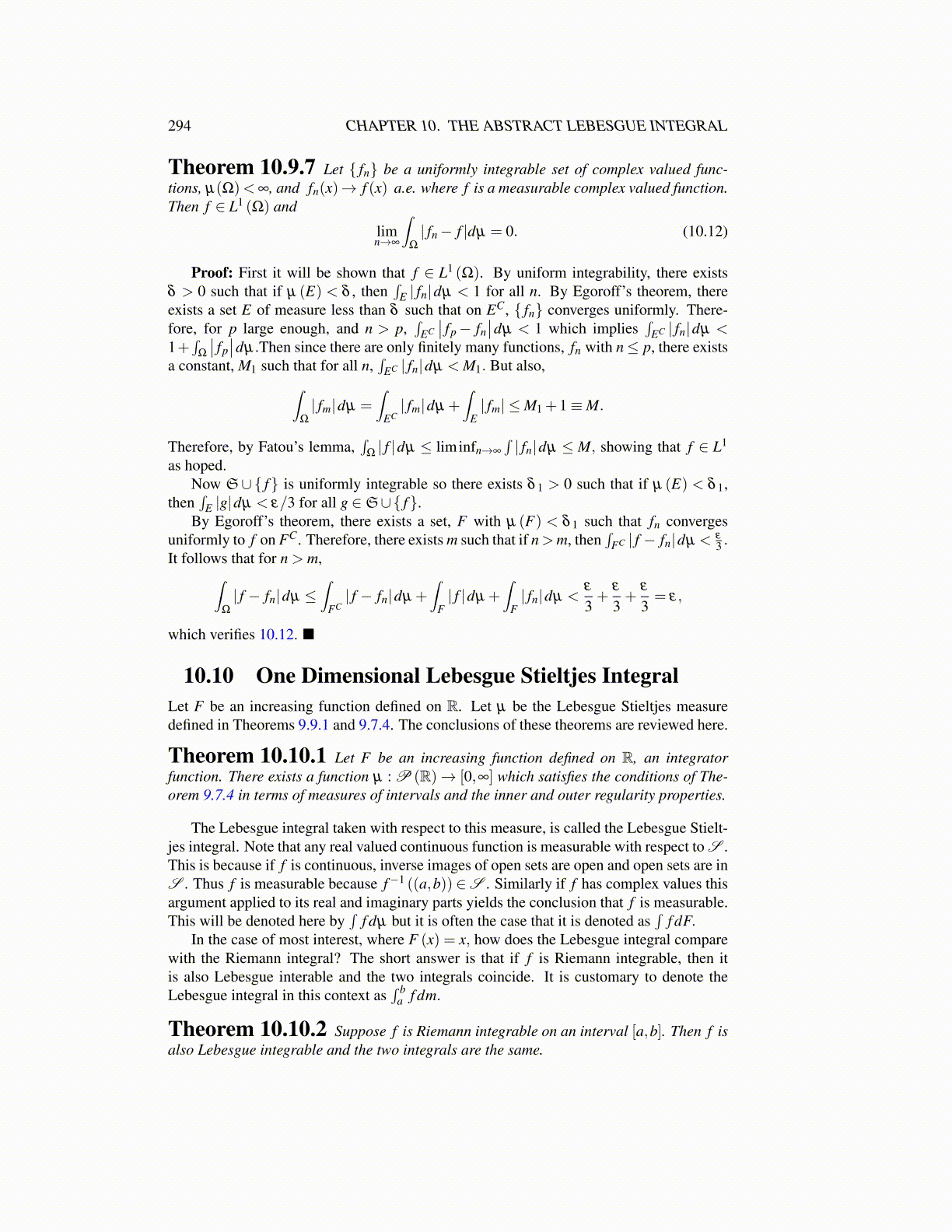
294 CHAPTER 10. THE ABSTRACT LEBESGUE INTEGRAL
Theorem 10.9.7 Let { fn} be a uniformly integrable set of complex valued func-tions, µ(Ω)< ∞, and fn(x)→ f (x) a.e. where f is a measurable complex valued function.Then f ∈ L1 (Ω) and
limn→∞
∫Ω
| fn− f |dµ = 0. (10.12)
Proof: First it will be shown that f ∈ L1 (Ω). By uniform integrability, there existsδ > 0 such that if µ (E) < δ , then
∫E | fn|dµ < 1 for all n. By Egoroff’s theorem, there
exists a set E of measure less than δ such that on EC, { fn} converges uniformly. There-fore, for p large enough, and n > p,
∫EC
∣∣ fp− fn∣∣dµ < 1 which implies
∫EC | fn|dµ <
1+∫
Ω
∣∣ fp∣∣dµ.Then since there are only finitely many functions, fn with n≤ p, there exists
a constant, M1 such that for all n,∫
EC | fn|dµ < M1. But also,∫Ω
| fm|dµ =∫
EC| fm|dµ +
∫E| fm| ≤M1 +1≡M.
Therefore, by Fatou’s lemma,∫
Ω| f |dµ ≤ liminfn→∞
∫| fn|dµ ≤ M, showing that f ∈ L1
as hoped.Now S∪{ f} is uniformly integrable so there exists δ 1 > 0 such that if µ (E) < δ 1,
then∫
E |g|dµ < ε/3 for all g ∈ S∪{ f}.By Egoroff’s theorem, there exists a set, F with µ (F) < δ 1 such that fn converges
uniformly to f on FC. Therefore, there exists m such that if n>m, then∫
FC | f − fn|dµ < ε
3 .It follows that for n > m,∫
Ω
| f − fn|dµ ≤∫
FC| f − fn|dµ +
∫F| f |dµ +
∫F| fn|dµ <
ε
3+
ε
3+
ε
3= ε,
which verifies 10.12. ■
10.10 One Dimensional Lebesgue Stieltjes IntegralLet F be an increasing function defined on R. Let µ be the Lebesgue Stieltjes measuredefined in Theorems 9.9.1 and 9.7.4. The conclusions of these theorems are reviewed here.
Theorem 10.10.1 Let F be an increasing function defined on R, an integratorfunction. There exists a function µ : P (R)→ [0,∞] which satisfies the conditions of The-orem 9.7.4 in terms of measures of intervals and the inner and outer regularity properties.
The Lebesgue integral taken with respect to this measure, is called the Lebesgue Stielt-jes integral. Note that any real valued continuous function is measurable with respect to S .This is because if f is continuous, inverse images of open sets are open and open sets are inS . Thus f is measurable because f−1 ((a,b)) ∈S . Similarly if f has complex values thisargument applied to its real and imaginary parts yields the conclusion that f is measurable.This will be denoted here by
∫f dµ but it is often the case that it is denoted as
∫f dF.
In the case of most interest, where F (x) = x, how does the Lebesgue integral comparewith the Riemann integral? The short answer is that if f is Riemann integrable, then itis also Lebesgue interable and the two integrals coincide. It is customary to denote theLebesgue integral in this context as
∫ ba f dm.
Theorem 10.10.2 Suppose f is Riemann integrable on an interval [a,b]. Then f isalso Lebesgue integrable and the two integrals are the same.